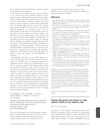TLDR Hair-follicle transplants can heal chronic skin ulcers.
Hair-follicle transplantation was explored as a treatment for chronic skin ulcers, which posed a significant challenge in clinical dermatology. The study highlighted a case where a chronic skin ulcer, caused by livedoid vasculopathy, fully healed within 2 months following the implantation of hair follicles into the wound bed. The improvement in healing was likely attributed to the action of follicle stem cells, suggesting a promising approach for treating such ulcers.
11 citations
,
January 2019 in “Dermatologic Surgery” Hair follicle transplants help heal wounds, but scar quality and hair growth vary by location.
 1 citations
,
June 2017 in “Actas Dermo-Sifiliográficas”
1 citations
,
June 2017 in “Actas Dermo-Sifiliográficas” Follicular Unit Extraction (FUE) is a hair transplant method with less scarring and discomfort but requires skilled surgeons and has limitations on graft numbers per session.
 17 citations
,
June 2020 in “British Journal of Dermatology”
17 citations
,
June 2020 in “British Journal of Dermatology” Oral mTOR inhibitors often cause skin and hair side effects but usually don't require stopping treatment.
 119 citations
,
January 2014 in “Indian Journal of Dermatology, Venereology and Leprology”
119 citations
,
January 2014 in “Indian Journal of Dermatology, Venereology and Leprology” Platelet-rich plasma might help with hair growth and skin conditions, but more research is needed to prove its effectiveness and safety.
 January 2017 in “Springer eBooks”
January 2017 in “Springer eBooks” The document explains various skin conditions and their treatments.
 43 citations
,
July 2014 in “Experimental Dermatology”
43 citations
,
July 2014 in “Experimental Dermatology” Hair follicles can help wounds heal faster and this knowledge could be used to treat chronic skin ulcers, with a potential use of a special stem cell hydrogel to enhance healing.
 6 citations
,
April 2022 in “Journal of diabetes research”
6 citations
,
April 2022 in “Journal of diabetes research” Type 2 diabetes slows down skin and hair renewal by blocking important stem cell activation in mice.







